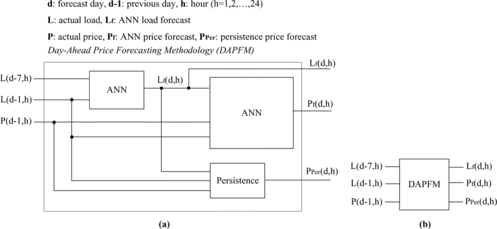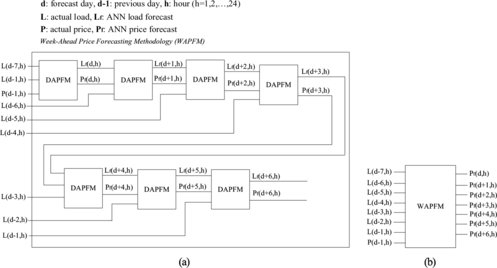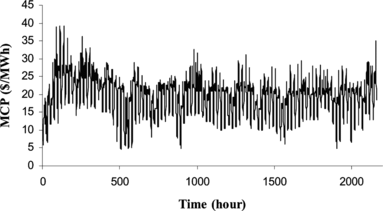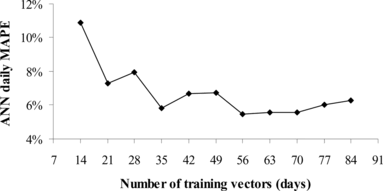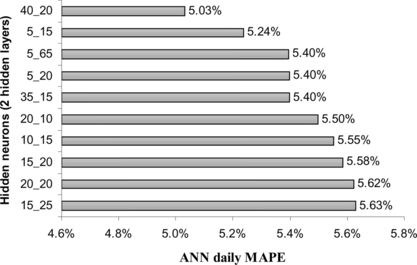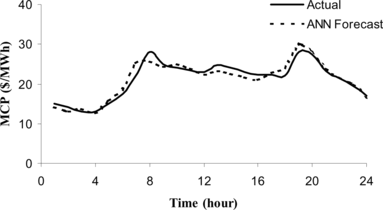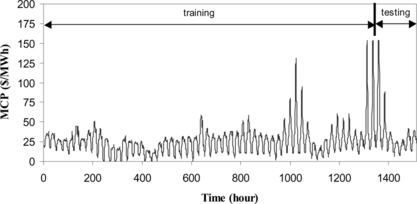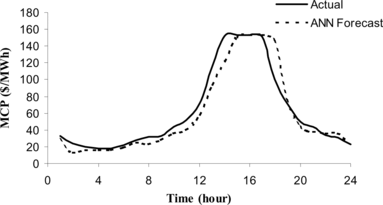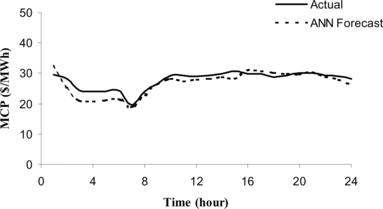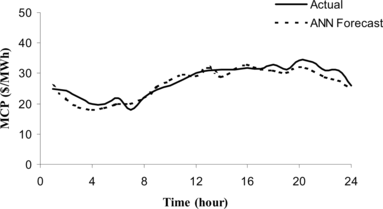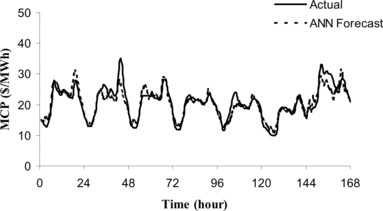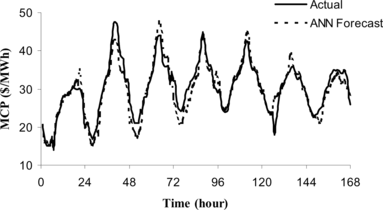Abstract
The market-clearing prices in deregulated electricity markets are volatile. Good market-clearing price forecasting will help producers and consumers to prepare their corresponding bidding strategies so as to maximize their profits. Market-clearing price prediction is a difficult task since bidding strategies used by market participants are complicated and various uncertainties interact in an intricate way. This article proposes the use of two artificial neural networks: the first to predict the day-ahead load and the second to forecast the day-ahead market-clearing prices. The methodology is applied to the California power market. After determining the optimal artificial neural network architecture with the minimum mean absolute percentage error on the test set, this architecture is used for price forecasting in periods with price spikes, for price forecasting for weekends, and for week-ahead MCP forecasting during the four seasons of the year. The forecasting accuracy of the artificial neural network model is compared with the accuracy of the persistence method and the results prove the efficiency and practicality of the proposed technique.
Deregulation has a great impact on the electric power industry nowadays (Georgilakis et al. Citation2001). In a deregulated environment, the intersection of the supply and demand curves represents the market-clearing price (MCP), i.e., the market equilibrium (Kirschen and Strbac Citation2004).
Producers and consumers rely on price forecast information to prepare their corresponding bidding strategies. A producer with low capability of altering MCPs (price-taker producer) needs day-ahead price forecasts to optimally self-schedule and to derive his bidding strategy in the pool (Arroyo and Conejo Citation2000; Chan Citation2000).
Retailers and large consumers need day-ahead MCPs for the same reasons as producers. If a consumer is to buy on the spot market, it is essential that he can predict as accurately as possible the evolution of MCPs over the time horizon used to self-schedule (Kirschen Citation2003).
The time framework to forecast the day-ahead MCPs in most markets is as follows (Conejo et al. Citation2005b). The MCPs for day d are required on day d-1, typically at hour hb (around 10 A.M.). On the other hand, data concerning results for day d-1 are available on day d-2 at hour hc (around 12 P.M.). Therefore, the actual forecasting of market prices for day d can take place between hour hc of day d-2 and hour hb of day d-1. Therefore, to forecast prices for day d, price data up to hour 24 of day d-1 are considered known.
MCP prediction is a difficult task (Schweppe et al. Citation1988) since bidding strategies used by market participants are complicated and various uncertainties interact in an intricate way. The complexity of MCP forecasting is also due to the number of influential factors and the lack of information on some of these factors. Since the MCP derives from the market equilibrium, it is influenced by both load and generation factors (Bunn Citation2000; Breipohl Citation2002; Kirschen and Strbac Citation2004). On the load side, all the temporal, meteorological, economic, and special factors that are used in load forecasting should also be taken into account when forecasting prices. The generation side is considerably more troublesome because some events occur at random (e.g., failures leading to withdrawal of capacity and price spikes) and others are not always publicly announced in advance (e.g., planned outages for maintenance). In addition, when the locational marginal price is needed, transmission congestion can have a sudden and-hard-to-predict effect. Finally, when competition is less perfect, some generators have the ability to influence prices to suit their own objectives. From this, it is concluded that MCPs are volatile and MCP prediction is a difficult task since bidding strategies used by market participants are complicated and various uncertainties interact in an intricate way.
In most electricity markets the series of prices presents the following features: 1) high frequency, 2) non-constant mean and variance, 3) daily and weekly seasonality, 4) calendar effect on weekends and holidays, 5) high volatility, and 6) presence of outliers.
Many attempts have been made to forecast electricity prices. Reported techniques include time series models, wavelet transform, and artificial neural networks.
Time series models are based on time series analysis. Linear regression time series models are not appropriate for MCP forecasting due to the presence of serial correlation in the errors (Conejo et al. Citation2005a). Therefore, it is necessary to use time series models that can handle correlated errors, such as ARIMA (Contreras et al. Citation2003; Conejo et al. Citation2005b), dynamic regression (Nogales et al. Citation2002), and transfer function models (Nogales et al. Citation2002; Conejo et al. Citation2005a). ARIMA relates current prices to past prices and current errors to previous errors. Dynamic regression relates current and past prices and demands. Transfer function relates current prices to past prices, demands, and errors.
The wavelet transform (Yao and Song Citation2000; Kim et al. Citation2002; Conejo et al. Citation2005b) converts an MCP series in a set (typically three to six) of constitutive series. These series present a better behavior (more stable variance and no outliers) than the original price series, and therefore, they can be predicted more accurately. The reason for the better behavior of the constitutive series is the filtering effect of the wavelet transform. In brief, the wavelet transform is used to decompose the ill-behaved price series into a set of better-behaved constitutive series. The future behavior of all the constitutive series is then predicted and the reverse wavelet transform is used to generate MCP prediction.
The artificial neural network (ANN) method, because of its ability to approximate any nonlinear function, is very promising in forecasting MCP time series. ANNs have been applied to forecasting prices in the England-Wales pool (Wang and Ramsay Citation1998), the Australian market (Szkuta et al. Citation1999), the California market (Shahidehpour et al. Citation2002; Yamin et al. Citation2004), the PJM Interconnection (Hong and Hsiao Citation2002), and the New England ISO (Zhang et al. Citation2003).
This article proposes the use of two artificial neural networks: the first to predict the day-ahead load and the second to forecast the day-ahead market-clearing prices. The methodology is applied to the California power market. After determining the optimal artificial neural network architecture with the minimum mean absolute percentage error on the test set, this architecture is used for price forecasting in periods with price spikes, for price forecasting for weekends, and for week-ahead MCP forecasting during the four seasons of the year. The forecasting accuracy of the artificial neural network model is compared with the accuracy of the persistence method and the results prove the efficiency and practicality of the proposed technique.
FORECASTING METHODOLOGY
Artificial Neural Network Model
ANN is a computer information processing system that is capable of sufficiently representing any nonlinear functions (Haykin Citation1999). The techniques based on ANN are especially effective in the solution of high complexity problems for which a traditional mathematical model is difficult to build, where the nature of the input-output relationship is neither well defined nor easily computable.
The most popular ANN architecture is the three-layer feed-forward system trained with a back-propagation algorithm. The success of this approach dwell in the fact that it can learn the relationship between input and output, by training the network offline using historical data derived from the system, with a supervised learning technique.
In the case of MCP forecasting, there is no simple relationship among the parameters involved in the determination of the MCP. ANNs, due to their highly nonlinear capabilities and universal approximation properties, are proposed in this article for MCP forecasting. At the training stage, the proper training set is identified and the proper ANN architecture (e.g., number and type of neurons and layers) is selected. The adaptive training mechanism allows the ANN to learn from its mistakes and correct its output by adjusting its neurons. The adaptive training process enhances the performance of the proposed module as additional training data are made available.
As input parameters to the ANN, three factors are considered: 1) historical MCP, 2) historical load, and 3) forecasted load. Historical information refers to the previous day's information, e.g., historical load information includes the 24 hourly actual (known) loads of the previous day. Similarly, forecasted load information includes the 24 hourly forecasted loads of the day-ahead, i.e., the day for which the MCP is to be forecasted. If all these three factors are considered as inputs to the ANN, then the input layer has 72 neurons. The proposed adaptive training mechanism ensures that the optimum number of hidden neurons is selected. The output layer of the ANN has 24 neurons, each one corresponding to the MCP of one of the 24 hours of the day ahead.
Persistence Method
In order to evaluate the performance of the ANN, its forecasts are compared with those of the persistence method. According to the persistence method, the forecasted price, Price(d, h), for the hour h of the day-ahead d is calculated as follows (Benini et al. Citation2002; Shahidehpour et al. Citation2002).
Performance Evaluation
To assess the prediction capacity of the ANN model and the persistence model, the mean absolute percentage error, MAPE, can be used.
However, the MAPE, as defined in Eq. (Equation2), is not suitable for price forecasting, since it causes problems for zero MCPs. To overcome this problem, the following calculation for the MAPE is used throughout this article (Shahidehpour et al. Citation2002; Yamin et al. Citation2004; Conejo et al. Citation2005b).
To assess the prediction capacity of the ANN model and the persistence model, the MAPE is used, as defined in Eq. (Equation3). The model (ANN or persistence) with the lower MAPE on the test set is the most suitable for MCP forecasting. In the sequel, if Eq. (Equation3) is used to calculate the performance of the day-ahead forecast, then the MAPE is called daily MAPE. While if Eq. (Equation3) is used to calculate the performance of the week-ahead forecast, then the MAPE is called weekly MAPE.
Overview of the Proposed Methodology
The proposed methodology for MCP forecasting has three steps.
-
In the first step, the day-ahead load is predicted with the ANN method.
-
In the second step, the MCPs are forecasted with the persistence method.
-
In the third step, the MCPs are forecasted with the ANN method.
The first step is to predict the day-ahead load, since this information is needed by the persistence method and also it is expected to be an important input parameter for the ANN model to predict the day-ahead MCPs. This load forecasting is implemented with a multilayer feed-forward neural network, which has 48 input neurons and 24 output neurons. The first 24 input neurons correspond to the 24 loads of the previous day (relatively to the day ahead) and the remaining 24 neurons correspond to the 24 loads of the same day (with the day ahead) of the previous week. The 24 output neurons correspond to the 24 loads of the day ahead.
The second step is to forecast MCPs with the persistence method by using Eq. (Equation1) and to evaluate the performance of the persistence method by using the MAPE definition of Eq. (Equation3).
The third step is to obtain the MCP forecast by using the ANN model. As reported in the next section “Case Study,” the best MCP forecasts are obtained by using 72 input neurons, out of which the 24 are for the 24 MCPs of the previous day, the next 24 neurons are for the previous day hourly loads, and the remaining 24 neurons correspond to the day-ahead hourly loads. The ANN has 24 output neurons, corresponding to day-ahead MCPs.
Figure presents the proposed day-ahead electricity price forecasting methodology (DAPFM). It should be noted that during the training process, the inputs and outputs of both ANNs (for load and MCP forecasting, within the first and the third step, respectively) are normalized, i.e., they are divided by the maximum value, e.g., the maximum load and this is applicable to the parameters Load(d-7, h), Load(d-1, h), and ANN_Load(d, h) that are shown in Figure . It was found that this normalization contributes in the accuracy of the proposed method irrespectively of the appearance of price spikes in the MCP data series.
Figure shows the proposed week-ahead electricity price forecasting methodology (WAPFM) that uses the DAPFM. More specifically, in the WAPFM:
Load forecast for the d day (obtained from DAPFM) acts as the previous day load for the d + 1 day forecast, and | |||||
Price forecast for the d day (obtained from DAPFM) acts as the previous day price for the d + 1 day forecast. | |||||
It should be noted that the WAPFM of Figure can be easily modified so as to be used for multiple days' forecasts.
CASE STUDY
The proposed forecasting model has been applied to predict the electricity prices of California power market. This section describes the methodology to select the optimum ANN architecture that provides the minimum daily mean absolute percentage error for the day-ahead electricity price forecasting problem. The selection of the optimum ANN architecture will define the number of training vectors, the number of input neurons, the number of hidden layers, the number of neurons per hidden layer, the training function, and the transfer function. The date of 29/3/1999 of the California power market has been selected to perform this case study. Figure presents the actual unconstrained MCP curve of the California power market from 1/1/1999 to 31/3/1999 (UCEI Citation2006), and Figure shows the actual load curve for the same period.
Day-Ahead Load Forecast
According to the proposed methodology, the first step is to predict the day-ahead load, i.e., the load for 29/3/1999. The day-ahead load forecast is needed by the persistence method and also it is expected to be an important input parameter for the ANN model to predict the day-ahead MCP.
After trial and error, it was found that the optimum day-ahead load forecasting results are obtained with an ANN having the architecture 48-15-24, i.e., 48 input neurons: 15 neurons in the hidden layer and 24 output neurons. For this ANN, the daily MAPE on the test set (24 hourly MCP for 29/3/1999) is 1.07%. Figure presents the ANN-based load forecast versus the actual load for 29/3/1999.
Day-Ahead MCP Forecast Using Persistence Method
The second step is to forecast day-ahead MCP with the persistence method. The results show that the daily MAPE on the test set (29/3/1999) is 7.60%. The persistence forecast will be compared with the ANN forecast for the day-ahead electricity price forecasting problem.
Selection of Training and Transfer Function
In order to select the best training and transfer functions for the ANN for the MCP forecasting problem, all possible combinations of the 17 different training functions, as shown in Table , and the 11 different transfer functions, as shown in Table , of the MATLAB neural network toolbox, are considered, in order to reach the best result, i.e., the minimum daily MAPE for the test set. Figure presents the combinations of training and transfer functions that gave the best 10 results. Figure shows that the best training function is traincgb and the best transfer functions is logsig, since this combination has the minimum daily MAPE, i.e., 5.49%. Traincgb is a network training function that updates weight and bias values according to the conjugate gradient back propagation with Powell-Beale restarts, and logsig is the log sigmoid transfer function.
FIGURE 6 Impact of training and transfer function on ANN-based daily mean absolute percentage errors (MAPE) for 29/3/1999.
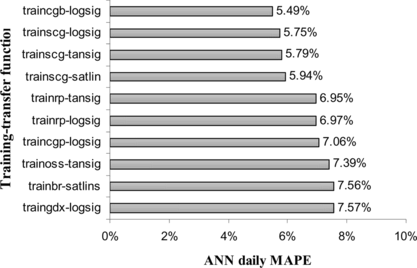
TABLE 1 Training Functions (Demuth and Beale Citation2001)
TABLE 2 Transfer Functions (Demuth and Beale Citation2001)
Selection of the Number of Training Vectors
In order to predict the 24 hourly MCPs for 29/3/1999, the appropriate number of training vectors has to be selected. Eleven different sizes of training vectors are considered, ranging from 14 days to 84 days. For example, if 14 days are selected, then the training period is from 15/3/1999 to 28/3/1999, i.e., the two weeks before the forecast day (29/3/1999), while if 84 days are selected, then the training period is from 4/1/1999 to 28/3/1999, i.e., the 12 weeks before the forecast day. Figure presents the impact of the number of training vectors on the daily MAPE for 29/3/1999. Figure shows that the optimum number of training vectors is 56 days, since this combination provides the minimum daily MAPE on the test set (29/3/1999), i.e., 5.49%.
Selection of the Number of Input Parameters
Table presents the impact of the number of input parameters on the forecasting performance for the test set. It is concluded from Table that the minimum MAPE (optimum performance) for MCP forecasting is obtained when using 72 input neurons that correspond to historical MCP (24 input neurons for the 24 hourly electricity prices of the previous day), historical load (24 input neurons for the 24 hourly loads of the previous day), and forecasted load (24 input neurons for the 24 hourly loads of the day ahead) as inputs to the ANN, in line with the proposed forecasting framework of Figure , since these inputs provide the minimum daily MAPE on the test set, i.e., 5.49%.
TABLE 3 Impact of Input Parameters on Forecasting Performance
Selection of the Number of Hidden Neurons
Two cases are considered regarding the number of hidden layers: one or two hidden layers. Figure presents the impact of the number of hidden neurons on the daily MAPE of 29/3/1999 for ANN architecture with one hidden layer. Based on Figure , the minimum daily MAPE is 5.33% and it is achieved with eight neurons in the hidden layer. Figure presents the impact of the number of hidden neurons on the daily MAPE of 29/3/1999 for ANN with two hidden layers. Figure shows that the optimum ANN has 40 neurons in the first hidden layer and 20 neurons in the second hidden layer and its MAPE is 5.03%, i.e., 5.63% lower that MAPE of the best ANN architecture with one hidden layer. In conclusion, the optimum ANN architecture for the day-ahead price forecasting problem has two layers, where the first hidden layer has 40 neurons and the second hidden layer has 20 neurons.
Optimum ANN for Day-Ahead MCP Forecast
Table presents the characteristics of the optimum ANN for day-ahead electricity price forecasting. The architecture of the optimum ANN is 72-40-20-24, i.e., the ANN has 72 input neurons, 40 neurons in the first hidden layer, 20 neurons in the second hidden layer, and 24 neurons in the output layer. The 24 output neurons correspond to the 24 hourly electricity prices of the day ahead. The 72 input neurons correspond to the 24 hourly electricity prices of the previous day (historical MCP), the 24 hourly loads of the previous day (historical load), and the 24 hourly loads of the day ahead (forecasted load). The optimum number of training vectors is 56 days before the day ahead. For example, if the forecast day is the 29/3/1999, then the optimum training period is from 1/2/1999 to 28/3/1999, i.e., the eight weeks (56 days) before the forecast day. The optimum training function is traincgb and the best transfer function is logsig.
TABLE 4 Architecture of the Optimum ANN for Electricity Price Forecasting
In Figure , the MCP forecast of the optimum ANN versus the actual MCP is shown for the test set (Monday 29/3/1999). The optimum ANN has been trained using the parameters of Table . The daily MAPE on the test set of the optimum ANN is 5.03%, i.e., 34% lower than the MAPE of the persistence method.
GENERALIZATION
This section is focused on the generalization of the proposed forecasting model. The ANN-based electricity price forecasting model is applied to predict the electricity prices of the California power market under many different special cases, such as forecasting periods with price spikes, forecasting MCP of weekends, and week-ahead price forecasting during the different seasons (winter, spring, summer, and fall) of the year.
Price Spikes
The generalization capability of the proposed model is checked during periods of price spikes. Let us suppose that we have to forecast the day-ahead electricity prices of Wednesday 14/7/1999. This is a very special day with price spikes, since at hours 14:00, 15:00, 16:00 and 17:00, the MCP is over 150 $/MWh.
Following the findings of Table , the number of training vectors is 56, i.e., the training period is from 19/5/1999 to 13/7/1999 and the testing period is 14/7/1999. Figure presents the MCP curve of the California power market from 19/5/1999 to 20/7/1999, where in purpose one week MCPs are presented for the testing period (instead of one day MCPs) so as the price spikes of the testing period are more visible. It should be noted that in this period, there are 11 hours during which the MCP is zero, so that is why MAPE is defined from Eq. (Equation3) instead from Eq. (Equation2).
In Figure , the MCP forecast of the optimum ANN versus the actual MCP is shown for the test set (Wednesday 14/7/1999). The optimum ANN has been trained using the parameters of Table . The daily MAPE on the test set of the optimum ANN is 12.36%, while the MAPE of the persistence method for the same problem is 17.46%, i.e., the proposed ANN method reduces the daily forecasting error by 29%. This result proves that the proposed ANN model is appropriate for MCP forecasting for all the days of the year, independently of the existence or not of price spikes.
Weekends
A second special case of the MCP forecasting problem is the day-ahead MCP forecasting for weekends, which presents significant difficulties (Wang and Ramsay Citation1998). The proposed methodology will be checked for the weekend of Saturday 18/9/1999 and Sunday 19/9/1999 for the California power market. In both cases (Saturday 18/9/1999 and Sunday 19/9/1999), the optimum ANN has been trained using the parameters of Table .
In Figure , the MCP forecast of the ANN versus the actual MCP is shown for Saturday 18/9/1999 (test set). The daily MAPE on the test set of the ANN is 5.61%, while the MAPE of the persistence method is 6.99%, i.e., the proposed ANN method reduces the daily forecasting error by 20%.
In Figure , the MCP forecast of the ANN versus the actual MCP is shown for Sunday 19/9/1999 (test set). The daily MAPE on the test set of the ANN is 5.90%, while the MAPE of the persistence method is 9.52%, i.e., the proposed ANN method reduces the daily forecasting error by 38% in comparison with persistence.
Week-Ahead
The proposed method of Figure is used for week-ahead price forecasting. The ANN is trained using the optimum parameters of Table . As the test set, the week from 30/3/1999 to 5/4/1999 is used, while the training period includes the 56 days from 2/2/1999 to 29/3/1999.
Figure presents the MCP forecast of the ANN versus the actual MCP for the test set. The weekly MAPE on the test set of the ANN is 7.66%, while the MAPE of the persistence method is 11.46%, i.e., the proposed ANN method reduces the weekly forecasting error by 33%.
In order to investigate the impact of adaptive training, this week-ahead forecasting problem is solved again, not using the methodology of Figure , but using an adaptive training mechanism according to which seven ANNs are trained for the seven days of the week ahead using each day the latest available data, i.e., the data of the previous day. Figure presents the MCP forecast of the ANN versus the actual MCP for the test set when using the adaptive training mechanism, instead of the methodology of Figure . The weekly MAPE on the test set of the adaptively trained ANN is 6.05%, while the MAPE of the persistence method is 11.46%, i.e., the adaptively trained ANN method reduces the weekly forecasting error by 47% in comparison with persistence method.
FIGURE 16 Adaptive trained ANN-based week-ahead MCP forecast versus actual MCP from 30/3/1999 to 5/4/1999.
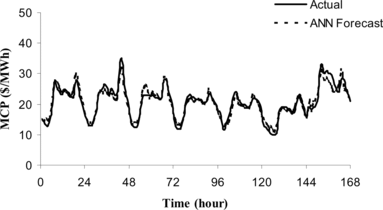
Table presents the daily mean errors of the week from 30/3/1999 to 5/4/1999 by persistence, ANN, and adaptively trained ANN method. The first conclusion from Table is that day 7 (5/4/1999) of the week ahead presents the highest daily mean errors. The second conclusion is that the best performing model is the adaptively trained ANN and the worst is the persistence method.
TABLE 5 Daily Mean Errors of the Week from 30/3/1999 to 5/4/1999 by Persistence, ANN, and Adaptive-Trained ANN
Seasons
The validity of the proposed week-ahead forecasting methodology of Figure is checked for four typical weeks of the four seasons, i.e., winter, spring, summer, and fall. The winter week is from 6/12/1999 to 12/12/1999 (test set). The spring week is from 12/4/1999 to 18/4/1999. The summer week is from 9/8/1999 to 15/8/1999. The fall week is from 6/9/1999 to 12/9/1999 (test set). In all four different cases, the ANN is trained using the optimum parameters of Table .
Figure presents the MCP forecast of the ANN versus the actual MCP for the winter week. The weekly MAPE on the test set of the ANN is 5.18%, while the MAPE of the persistence method is 6.56%, i.e., the proposed ANN method reduces the weekly forecasting error by 26%.
FIGURE 17 ANN-based week-ahead MCP forecast versus actual MCP for winter week (from 6/12/1999 to 12/12/1999).
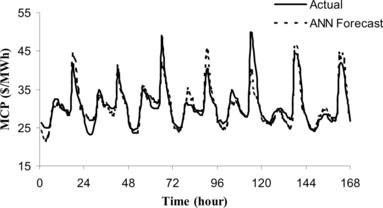
For the spring week, the weekly error of the ANN is 4.77%, while the weekly error of the persistence method is 6.35%. Figure presents the MCP forecast of the ANN versus the actual MCP for the spring week.
FIGURE 18 ANN-based week-ahead MCP forecast versus actual MCP for spring week (from 12/4/1999 to 18/4/1999).
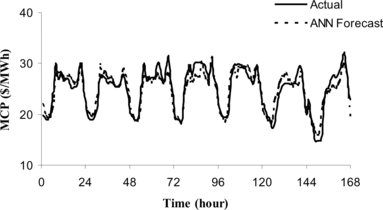
For the summer week, the prediction behavior of the ANN technique is less accurate than for the winter and spring weeks. More specifically, for the summer week, the weekly error of the ANN is 6.87%, while the weekly error of the persistence method is 9.51%. Figure presents the MCP forecast of the ANN versus the actual MCP for the summer week.
FIGURE 19 ANN-based week-ahead MCP forecast versus actual MCP for summer week (from 9/8/1999 to 15/8/1999).
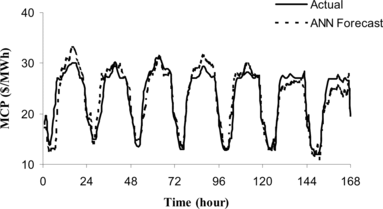
The weekly error of the ANN for the fall week is closer to the weekly error of the summer week. More specifically, for the fall week, the weekly error of the ANN is 6.03%, while the weekly error of the persistence method is 8.11%. Figure presents the MCP forecast of the ANN versus the actual MCP for the fall week.
CONCLUSIONS
The objective of this article is to develop a technique for the prediction of the hourly market clearing price in a deregulated electricity market environment using only the publicly available information. The proposed method uses two ANNs: the first ANN predicts the hourly load and the second ANN estimates the hourly market clearing price. The output of the first ANN together with the previous day load and the previous day market-clearing price are used as input to the second ANN. The inputs and outputs of both ANNs are normalized during ANN training and this normalization contributes in the accuracy of the proposed method. The testing MAPE of the second ANN is compared with the testing MAPE of a persistence method.
The methodology is applied to the California power market and it was found that the ANN efficiently estimates the electricity prices, since the ANN MAPE on the test set is on average 6%, which is 30% better than the testing MAPE of the persistence method. In case of price spikes, the ANN MAPE is on average 12%, which is also 30% better than the testing MAPE of the persistence method. These results prove the efficiency and practicality of the proposed ANN method for forecasting the market-clearing price in deregulated electricity markets.
REFERENCES
- Arroyo , J. M. and A. J. Conejo . 2000 . Optimal response of a thermal unit to an electricity spot market . IEEE Transactions on Power Systems 15 : 1098 – 1104 .
- Benini , M. , M. Marracci , P. Pelacchi , and A. Venturini . 2002 . Day-ahead market price volatility analysis in deregulated electricity markets . In Proceedings of the IEEE Power Engineering Society Summer Meeting , pages 1354 – 1359 .
- Breipohl , A. M. 2002 . Electricity price forecasting models . In Proceedings of the IEEE Power Engineering Society Winter Meeting , pages 963 – 966 .
- Bunn , D. W. 2000 . Forecasting loads and prices in competitive power markets . Proceedings of the IEEE 88 ( 2 ): 163 – 169 .
- Chan , C. J. S. 2000 . Development of a Profit Maximization Unit Commitment Program . MSc. dissertation, UMIST , UK .
- Conejo , A. J. , J. Contreras , R. Espandiacute;nola , and M. A. Plazas . 2005a . Forecasting electricity prices for a day-ahead pool-based electric energy market . International Journal of Forecasting 21 : 435 – 462 .
- Conejo , A. J. , M. A. Plazas , R. Espandiacute;nola , and A. B. Molina . 2005b . Day-ahead electricity price forecasting using the wavelet transform and ARIMA models . IEEE Transactions on Power Systems 20 ( 2 ): 1035 – 1042 .
- Contreras , J. , R. Espandiacute;nola , F. G. Nogales , and A. J. Conejo . 2003 . ARIMA models to predict next-day electricity prices . IEEE Transactions on Power Systems 18 : 1014 – 1020 .
- Demuth , H. and M. Beale . 2001 . Neural Network Toolbox For Use with MATLAB, User's Guide, Version 4 . MA : Math Works .
- Georgilakis , P. S. , N. D. Doulamis , A. D. Doulamis , N. D. Hatziargyriou , and S. D. Kollias . 2001 . A novel iron loss reduction technique for distribution transformers based on a combined genetic algorithm-neural network approach . IEEE Transactions on Systems, Man, and Cybernetics, Part C: Applications and Reviews 31 ( 1 ): 16 – 34 .
- Haykin , S. 1999 . Neural Networks: A Comprehensive Foundation . New Jersey : Prentice-Hall .
- Hong , Y.-Y. and C.-Y. Hsiao . 2002 . Locational marginal price forecasting in deregulated electricity markets using artificial intelligence . IEEE Proceedings-Generation Transmission Distribution 149 ( 5 ): 621 – 626 .
- Kim , C.-I. , I.-K. Yu , and Y. H. Song . 2002 . Prediction of system marginal price of electricity using wavelet transform analysis . Energy Conversion and Management 43 : 1839 – 1851 .
- Kirschen , D. S. 2003 . A demand-side view of electricity markets . IEEE Transactions on Power Systems 18 : 520 – 527 .
- Kirschen , D. S. and G. Strbac . 2004 . Fundamentals of Power System Economics . Chichester : John Wiley & Sons .
- Math Works . 2001 . Getting Started with MATLAB, Version 6 . MA : Math Works .
- Nogales , F. G. , J. Contreras , A. J. Conejo , and R. Espandiacute;nola . 2002 . Forecasting next-day electricity prices by time series models . IEEE Transactions on Power Systems 17 : 342 – 348 .
- Schweppe , F. , M. Caramanis , R. Tabors , and R. Bohn . 1988 . Spot Pricing of Electricity . Norwell , MA : Kluwer .
- Shahidehpour , M. , H. Yamin , and Z. Li . 2002 . Market Operations in Electric Power Systems: Forecasting, Scheduling, and Risk Management . New York : John Wiley & Sons .
- Szkuta , B. R. , L. A. Sanabria , and T. S. Dillon . 1999 . Electricity price short-term forecasting using artificial neural networks . IEEE Transactions on Power Systems 14 ( 3 ): 851 – 857 .
- UCEI. 2006. University of California Energy Institute, California Electricity Market Data. [Online]. Available : http://www.ucei.berkeley.edu/ucei/da-tamine/datamine.htm
- Wang , A. J. , and B. Ramsay . 1998 . A neural network based estimator for electricity spot-pricing with particular reference to weekend and public holidays . Neurocomputing 23 : 47 – 57 .
- Yamin , H. Y. , M. Shahidehpour , and Z. Li . 2004 . Adaptive short-term electricity price forecasting using artificial neural networks in the restructured power markets . International Journal of Electrical Power & Energy Systems 26 : 571 – 581 .
- Yao , S. J. , and Y. H. Song . 2000 . Prediction of system marginal prices by wavelet transform and neural network . Elect. Mach. Power Syst. 28 : 983 – 993 .
- Zhang , L. , P. B. Luh , and K. Kasiviswanathan . 2003 . Energy clearing price prediction and confidence interval estimation with cascaded neural networks . IEEE Transactions on Power Systems 18 ( 1 ): 99 – 105 .
